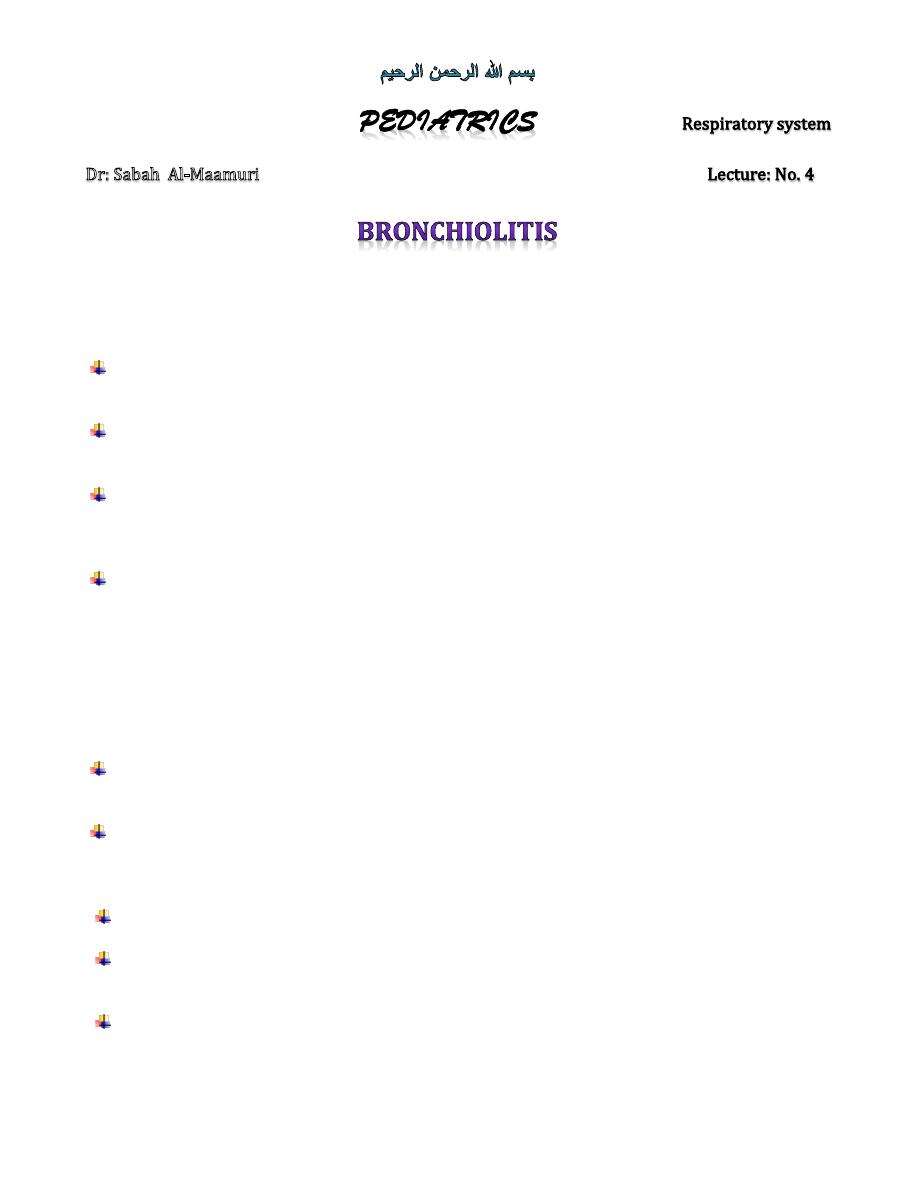
1
Acute bronchiolitis is a common disease of the lower respiratory tract (LRT) in infants, resulting
from an inflammatory obstruction of the small airways. The peak incidence is around 6 months of age
ranging from 1 month –2 years, whereas the severe disease is more common infants aged 1-3 months.
Bronchiolitis is a seasonal disease, with a peak activity during winter & early spring.
Etiology & epidemiology
Predominantly a viral disease. RSV is responsible for >50% of cases. Other agents include
parainfluenza, adenovirus, and Mycoplasma. Human metapneumovirus and human bocavirus,
which may be a primary cause of viral respiratory infection or occur as a co-infection with RSV.
There is no evidence of bacterial cause for bronchiolitis, although bacterial pneumonia is
sometimes confused clinically with bronchiolitis & bronchiolitis is rarely followed by bacterial
super infection.
Bronchiolitis is more common in boy in those who not have been breast fed, & in those who live
in crowded conditions. Older family members are common source of infection but may
experience only minor symptoms.
Pathophysiology
Not all infected infants develop LRTI. Host anatomic and immunologic factors play a significant
role in the severity of the clinical syndrome, as does the nature of the viral pathogen. Infants
with pre-existent smaller airways and diminished lung function have a more-severe course. In
addition, RSV infection incites a complex immune response. Eosinophils degranulate and
release eosinophil cationic protein, which is cytotoxic to airway epithelium. Innate immunity
plays a significant role and can depend on polymorphisms in toll-like receptor (TLR),
interferon (IF), interleukins (IL), and nuclear factor κB (NFκB). Chemokines and cytokines such
as tumor necrosis factor α (TNF-α) may be differentially expressed depending on the inciting
virus.
Acute bronchiolitis is characterized by bronchiolar obstruction with edema , mucus, & cellular
debris. If obstruction is complete with resorption of the trapped air, the child will develop
atelactasis.
Hypoxemia is a consequence of ventilation-perfusion mismatch early in the course. With severe
disease, hypercapnia develops.
Clinical Manifestations
The illness is usually preceded by exposure to an older contact with a minor respiratory
syndrome within the previous week.
The infants 1
st
develop a mild upper respiratory tract (URT) infection with sneezing & clear
rhinorrhea. This may be accompanied by ↓appetite & fever (ranging from subnormal to
markedly ↑temperature).
Gradually, respiratory distress ensues with paroxysmal wheezy cough, dyspnea, & irritability. The
infants are often tachypneic which interferes with feeding. The child does not usually have
other systemic complaints as diarrhea & vomiting. Apnea may be more prominent than
wheezing early in the course of the disease, particularly in very young infants.

2
The physical examination is characterized is often dominated by wheezing. The degree of
tachypnea does not always correlate with the degree of hypoxemia or hypercarbia, so pulse
oximetry and noninvasive determination of carbon dioxide is essential. Work of breathing may
be markedly increased, with nasal flaring and retractions. Auscultation might reveal fine
crackles or overt wheezes, with prolongation of the expiratory phase of breathing. Barely
audible breath sounds suggest very severe disease with nearly complete bronchiolar
obstruction. Hyperinflation of the lungs can permit palpation of the liver and spleen.
The single best indicator at the initial assessment appears to be the O2 saturation which can be
determined by pulse oximetry. SaO2 <95% correlates with more severe disease. An arterial
blood gas with PaO2 of ≤65 mmHg or PaCO2 of > 40 mmHg is particularly worrisome. Other
predictors of ↑severity include: an ill or toxic appearance, history of prematurity (gestational
age < 34 wk), atelactasis on CXR, respiratory rate (RR) > 70 beat per minute (bpm), infants <3
months old, & with underlying diseases as congenital heart diseases (CHD), bronchopulmonary
dysplasia (BPD), immunodeficiency, & asthma.
Diagnosis
o
Diagnosis is clinical.
o
CXR →hyper inflated lungs with patchy atelectasis.
o
WBC count & differential counts are usually normal without lymphopenia seen with other viral
illnesses.
o
Viral testing (usually rapid immunofluorescence, PCR, & viral culture).
Differential diagnosis
Asthma : It is most commonly confused with acute bronchiolitis. The 2 conditions maynot be
distinguished during the 1st episode, but repeated episodes of wheezing, absence ofthe viral
prodrome, & presence of family history of atopy, or asthma support thediagnosis of asthma.
Foreign body in the trachea.
Tracheomalacia, bronchomalacia, vascular ring.
CHF, cystic fibrosis, pertussus, GER.
Treatment
■
Hospitalization
Age < 12 wks.
Preterm
Cardiovascular, pulmonary, or immunologic disease.
Extreme tachypnea
Inability to take oral feedings
Hypoxia.
Supportive measures.
Hypoxemic children should receive cool humidified oxygen.
Sedatives are to be avoided because they can depress respiratory drive.
The infant is sometimes more comfortable if sitting with head and chest elevated at a
30-degree angle with neck extended.
The infant may be fed through a nasogastric tube risk of aspiration of oral feedings may
be high in infants with bronchiolitis, owing to tachypnea and the increased work of
breathing.
High-flow nasal cannula therapy can reduce the need for intubation in patients with
impending respiratory failure.
Frequent suctioning of nasal and oral secretions often provides relief of distress or
cyanosis.
Infant should not be fed orally but be maintained with parenteral fluids.
Medication
Bronchodilators can produce modest short-term improvement in clinical features.

3
Corticosteroids, whether parenteral, oral, or inhaled, have been used for bronchiolitis
despite conflicting and often negative studies. Corticosteroids are not recommended in
previously healthy infants with RSV.
Ribavirin, an antiviral agent administered by aerosol, has been used for infants with
congenital heart disease or chronic lung disease.
Antibiotics have no value unless there is coexisting bacterial infection.
No support for RSV immunoglobulin administration during acute episodes of RSV
bronchiolitis in previously healthy children.
Combined therapy with nebulized epinephrine and dexamethasone has been used but is
not currently recommended.
Nebulized hypertonic saline has also been reported to have some benefit.
Prognosis
The case fatality rate is <1%, with death attributable to apnea, respiratory arrest, or severe dehydration. After
this critical period, symptoms can persist.
The median duration of symptoms in ambulatory patients is
∼12 days.
There is a higher incidence of wheezing and asthma in children with a history of bronchiolitis unexplained
by family history or other atopic syndromes.
It is unclear whether bronchiolitis incites an immune response that manifests as asthma later or whether
those infants have an inherent predilection for asthma that is merely unmasked by their episode of RSV.
Approximately 60% of infants who wheeze will stop wheezing.
Prevention
RSV–IVIG (intravenous immunoglobulins) & IM monoclonal antibodies to RSV (palivizumab) are
effective in preventing severs RSV disease in the high-risk infants when given before & during
RSV season. Pailvizumab is recommended for infants < 2 yrs of age with chronic lung disease
(BPD) or prematurity.
Meticulous hand washing is the best measure to prevent the nosocomial transmission.
